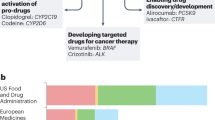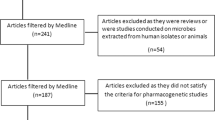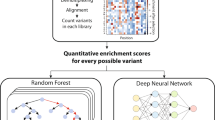Abstract
Pharmacogenetics, one of the cornerstones of personalized medicine, has the potential to change the way in which health care is offered by stratifying patients into various pretreatment categories, such as likely responders, likely non-responders or likely to experience adverse drug reactions. In order to advance drug development and regulatory science, regulatory agencies globally have promulgated guidelines on pharmacogenetics for nearly a decade. The aim of this article is to provide an overview of new guidelines for the implementation of pharmacogenetics in drug development from a multiregional regulatory perspective — encompassing Europe, the United States and Japan — with an emphasis on clinical pharmacokinetics.
This is a preview of subscription content, access via your institution
Access options
Subscribe to this journal
Receive 12 print issues and online access
$209.00 per year
only $17.42 per issue
Buy this article
- Purchase on Springer Link
- Instant access to full article PDF
Prices may be subject to local taxes which are calculated during checkout


Similar content being viewed by others
References
Katz, D. A., Murray, B., Bhathena, A. & Sahelijo, L. Defining drug disposition determinants: a pharmacogenetic-pharmacokinetic strategy. Nature Rev. Drug Discov. 7, 293–305 (2008).
Williams, J. A. et al. PhRMA white paper on ADME pharmacogenomics. J. Clin. Pharmacol. 48, 849–889 (2008).
Phillips, K. A. & Van Bebber, S. L. Measuring the value of pharmacogenomics. Nature Rev. Drug Discov. 4, 500–509 (2005).
Weinshilboum, R. & Wang, L. Pharmacogenomics: bench to bedside. Nature Rev. Drug Discov. 3, 739–748 (2004).
Zineh, I. & Pacanowski, M. A. Pharmacogenomics in the assessment of therapeutic risks versus benefits: inside the United States Food and Drug Administration. Pharmacotherapy 31, 729–735 (2011).
Ozsolak, F. Third-generation sequencing techniques and applications to drug discovery. Expert Opin. Drug Discov. 7, 231–243 (2012).
Frueh, F. W. et al. Pharmacogenomic biomarker information in drug labels approved by the United States Food and Drug Administration: prevalence of related drug use. Pharmacotherapy 28, 992–998 (2008).
Evans, W. E. & Relling, M. V. Pharmacogenomics: translating functional genomics into rational therapeutics. Science 286, 487–491 (1999).
Eichelbaum, M., Ingelman-Sundberg, M. & Evans, W. E. Pharmacogenomics and individualized drug therapy. Annu. Rev. Med. 57, 119–137 (2006).
Daly, A. K. Pharmacogenetics and human genetic polymorphisms. Biochem. J. 429, 435–449 (2010).
Lenzini, P. et al. Integration of genetic, clinical, and INR data to refine warfarin dosing. Clin. Pharmacol. Ther. 87, 572–578 (2010).
Teichert, M. et al. A genome-wide association study of acenocoumarol maintenance dosage. Hum. Mol. Genet. 18, 3758–3768 (2009).
Sim, S. C. & Ingelman-Sundberg, M. Pharmacogenomic biomarkers: new tools in current and future drug therapy. Trends Pharmacol. Sci. 32, 72–81 (2011).
Shuldiner, A. R. et al. Association of cytochrome P450 2C19 genotype with the antiplatelet effect and clinical efficacy of clopidogrel therapy. JAMA 302, 849–857 (2009).
Mega, J. L. et al. Reduced-function CYP2C19 genotype and risk of adverse clinical outcomes among patients treated with clopidogrel predominantly for PCI: a meta-analysis. JAMA 304, 1821–1830 (2010).
Mega, J. L. et al. Genetic variants in ABCB1 and CYP2C19 and cardiovascular outcomes after treatment with clopidogrel and prasugrel in the TRITON-TIMI 38 trial: a pharmacogenetic analysis. Lancet 376, 1312–1319 (2010).
Ishiguro, A., Toyoshima, S. & Uyama, Y. Current Japanese regulatory situations of pharmacogenomics in drug administration. Expert Rev. Clin. Pharmcol 1, 505–514 (2008).
Uyama, Y., Ishiguro, A., Nakamura, H. & Nakamura, H. in Predictive Approaches in Drug Discovery and Development: Biomarkers and In Vitro/In Vivo CorrelationsCh. 11 (eds Williams, J., Lalonde, R.,Koup, J. & DD, C.) (John Wiley & Sons, 2012).
Lesko, L. J. & Woodcock, J. Pharmacogenomic-guided drug development: regulatory perspective. Pharmacogenom. J. 2, 20–24 (2002).
Goodsaid, F. & Papaluca, M. Evolution of biomarker qualification at the health authorities. Nature Biotechnol. 28, 441–443 (2010).
Goodsaid, F. M. et al. Voluntary exploratory data submissions to the US FDA and the EMA: experience and impact. Nature Rev. Drug Discov. 9, 435–445 (2010).
Issa, A. M. Ethical perspectives on pharmacogenomic profiling in the drug development process. Nature Rev. Drug Discov. 1, 300–308 (2002).
Kohane, I. S., Hsing, M. & Kong, S. W. Taxonomizing, sizing, and overcoming the incidentalome. Genet. Med. 14, 399–404 (2012).
Kohane, I. S. (Mis)treating the pharmacogenetic incidentalome. Nature Rev. Drug Discov. 11, 89–90 (2012).
Kohane, I. S., Masys, D. R. & Altman, R. B. The incidentalome: a threat to genomic medicine. JAMA 296, 212–215 (2006).
Kohane, I. S. et al. Medicine. Reestablishing the researcher–patient compact. Science 316, 836–837 (2007).
Shah, J. Economic and regulatory considerations in pharmacogenomics for drug licensing and healthcare. Nature Biotechnol. 21, 747–753 (2003).
Paulmichl, M. et al. New mammalian chloride channel identified by expression cloning. Nature 356, 238–241 (1992).
Giacomini, K. M. et al. Membrane transporters in drug development. Nature Rev. Drug Discov. 9, 215–236 (2010).
Pasanen, M. K., Neuvonen, M., Neuvonen, P. J. & Niemi, M. SLCO1B1 polymorphism markedly affects the pharmacokinetics of simvastatin acid. Pharmacogenet. Genom. 16, 873–879 (2006).
Ho, R. H. et al. Drug and bile acid transporters in rosuvastatin hepatic uptake: function, expression, and pharmacogenetics. Gastroenterology 130, 1793–1806 (2006).
Link, E. et al. SLCO1B1 variants and statin-induced myopathy — a genomewide study. N. Engl. J. Med. 359, 789–799 (2008).
Furst, J. et al. The ICln interactome. Acta Physiol. (Oxf.) 187, 43–49 (2006).
Ge, H., Liu, Z., Church, G. M. & Vidal, M. Correlation between transcriptome and interactome mapping data from Saccharomyces cerevisiae. Nature Genet. 29, 482–486 (2001).
Lim, J. et al. A protein–protein interaction network for human inherited ataxias and disorders of Purkinje cell degeneration. Cell 125, 801–814 (2006).
Rual, J. F. et al. Towards a proteome-scale map of the human protein–protein interaction network. Nature 437, 1173–1178 (2005).
Stumpf, M. P. et al. Estimating the size of the human interactome. Proc. Natl Acad. Sci. USA 105, 6959–6964 (2008).
Venkatesan, K. et al. An empirical framework for binary interactome mapping. Nature Methods 6, 83–90 (2009).
Vidal, M., Cusick, M. E. & Barabasi, A. L. Interactome networks and human disease. Cell 144, 986–998 (2011).
Yu, H. et al. Next-generation sequencing to generate interactome datasets. Nature Methods 8, 478–480 (2011).
Mirnezami, R., Nicholson, J. & Darzi, A. Preparing for precision medicine. N. Engl. J. Med. 366, 489–491 (2012).
[No authors listed]. Moving toward precision medicine. Lancet 378, 1678 (2011).
Lesko, L. J. & Woodcock, J. Translation of pharmacogenomics and pharmacogenetics: a regulatory perspective. Nature Rev. Drug Discov. 3, 763–769 (2004).
Lindpaintner, K. The impact of pharmacogenetics and pharmacogenomics on drug discovery. Nature Rev. Drug Discov. 1, 463–469 (2002).
Ma, Q. & Lu, A. Y. Pharmacogenetics, pharmacogenomics, and individualized medicine. Pharmacol. Rev. 63, 437–459 (2011).
Wang, L., McLeod, H. L. & Weinshilboum, R. M. Genomics and drug response. N. Engl. J. Med. 364, 1144–1153 (2011).
Flaherty, K. T. et al. Inhibition of mutated, activated BRAF in metastatic melanoma. N. Engl. J. Med. 363, 809–819 (2010).
Karapetis, C. S. et al. K-ras mutations and benefit from cetuximab in advanced colorectal cancer. N. Engl. J. Med. 359, 1757–1765 (2008).
Duncan, S. R., Scott, S. & Duncan, C. J. Reappraisal of the historical selective pressures for the CCR5- Δ32 mutation. J. Med. Genet. 42, 205–208 (2005).
Roudier, J. HLA-DRB1 genes and extraarticular rheumatoid arthritis. Arthritis Res. Ther. 8, 103 (2006).
Acknowledgements
The authors greatly appreciated helpful discussions with I. Kohane (Harvard, USA), R. Diasio (Mayo Clinic, USA) and F. Innocenti (University of North Carolina, Chapel Hill, USA). C.N. is supported by the Lise Meitner stipend of the Fonds zur Förderung der Wissenschaftlichen Forschung (FWF) (M11108-B11). Further support was given by the FWF and the FP-7 to M. Paulmichl (P18608; PIRSES-GA-2008-230661). The authors acknowledge the expert secretarial assistance of E. Mooslechner.
Author information
Authors and Affiliations
Corresponding author
Ethics declarations
Competing interests
The authors declare no competing financial interests.
Related links
Related links
FURTHER INFORMATION
Committee for Medicinal Products for Human Use
EMA — Qualification of novel methodologies for medicine development
EMA workshop on pharmacogenomics: from science to clinical care
International Conference on Harmonisation — Guidelines
Pharmacogenomics Working Party
Glossary
- Adverse drug reactions
-
(ADRs). Noxious, undesired or unintended responses to pharmacological treatments that occur at dosages used for prophylaxis, diagnosis or therapy of diseases.
- Enrichment studies
-
Clinical studies in which patient subsets are enrolled or analysed in order to increase the likelihood for demonstrating a specific treatment effect (if one exists).
- Genetic subpopulations
-
Groups of individuals sharing the same genetic variants. Ethnicity is not included in the context here.
- Interactome
-
The entire set of protein–protein interactions that occur in a cell.
- Pharmacodynamics
-
(PD). The desired or adverse biological (for example, biochemical or physiological) effect of a drug on the body.
- Pharmacogenetics
-
According to the definitions set by the International Conference on Harmonisation Topic E15 guideline, pharmacogenetics is a subset of pharmacogenomics that studies variations in DNA sequence as related to drug response.
- Pharmacogenomics
-
According to the definitions set by the International Conference on Harmonisation Topic E15 guideline, pharmacogenomics is the study of variations in DNA and RNA characteristics as related to drug response.
- Pharmacokinetics
-
(PK). How the body affects a drug over a period of time as a function of absorption, distribution, metabolism and excretion.
- Pharmacovigilance
-
A pharmacological science related to the detection, assessment and prevention of adverse drug reactions in the post-marketing period of a drug's life cycle.
- Phenotyping
-
Grouping of individuals based on measurement of an observable characteristic (for example, the extent to which they are able to metabolize a drug or other substrate).
Rights and permissions
About this article
Cite this article
Maliepaard, M., Nofziger, C., Papaluca, M. et al. Pharmacogenetics in the evaluation of new drugs: a multiregional regulatory perspective. Nat Rev Drug Discov 12, 103–115 (2013). https://doi.org/10.1038/nrd3931
Published:
Issue Date:
DOI: https://doi.org/10.1038/nrd3931
This article is cited by
-
Efficacy and safety of duloxetine and Pregabalin in Iranian patients with diabetic peripheral neuropathic pain: a double-blind, randomized clinical trial
Journal of Diabetes & Metabolic Disorders (2019)
-
Pharmacogenetics and the print media: what is the public told?
BMC Medical Genetics (2015)
-
Pharmacogenomic information in drug labels: European Medicines Agency perspective
The Pharmacogenomics Journal (2015)
-
A Question-Based Approach to Adopting Pharmacogenetics to Understand Risk for Clinical Variability in Pharmacokinetics in Early Drug Development
Clinical Pharmacology & Therapeutics (2014)
-
Policies to aid the adoption of personalized medicine
Nature Reviews Drug Discovery (2014)



